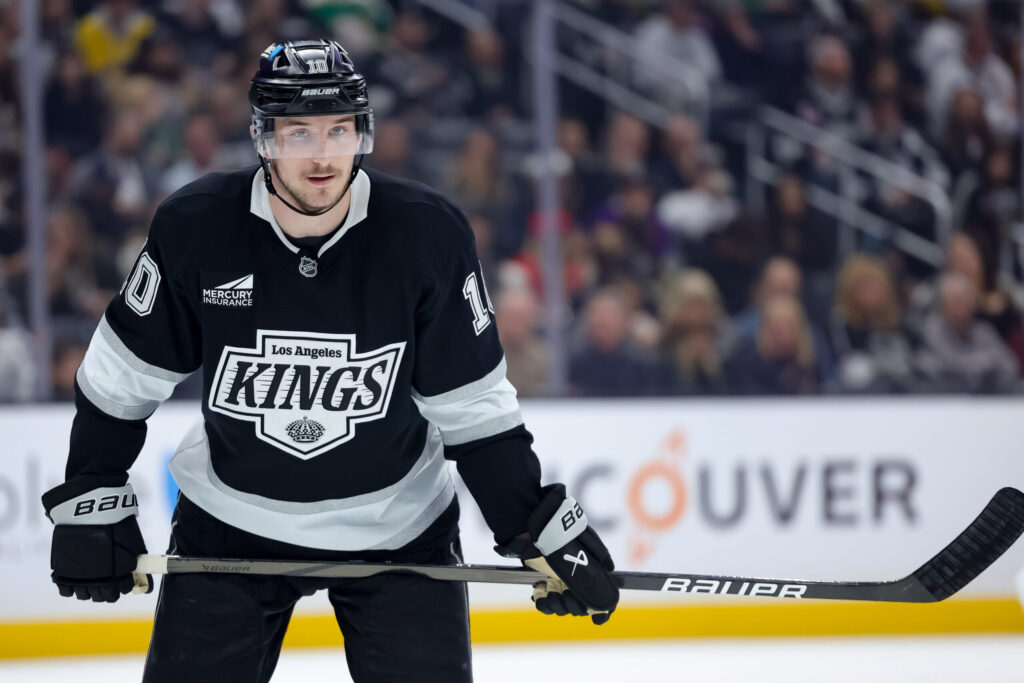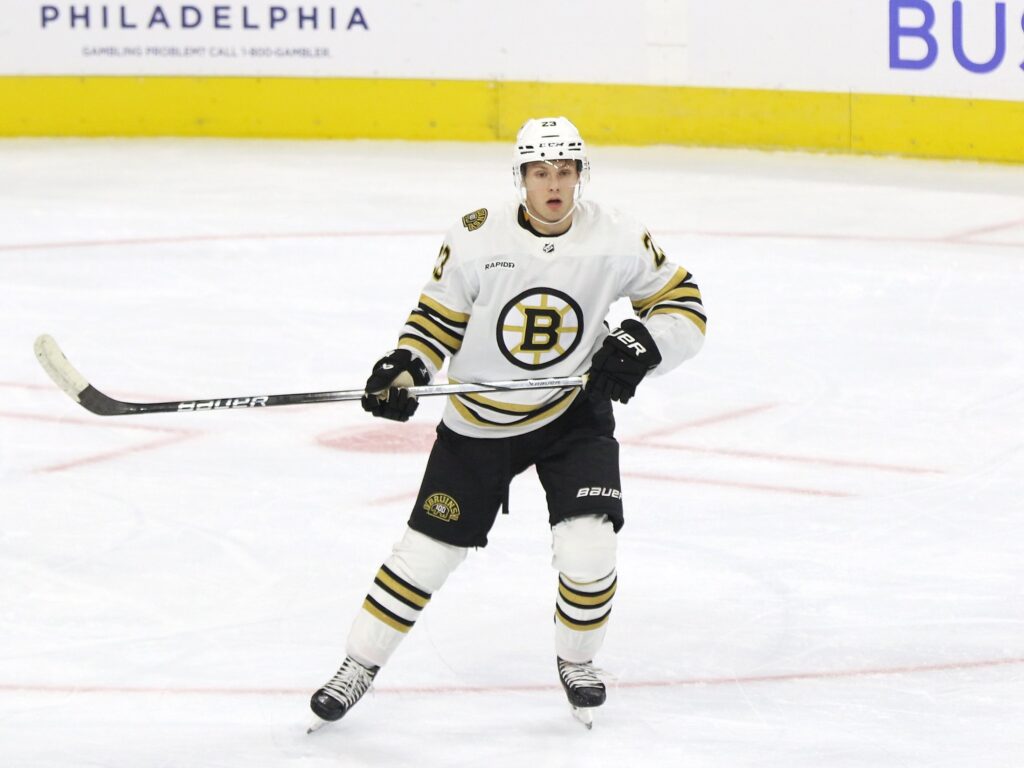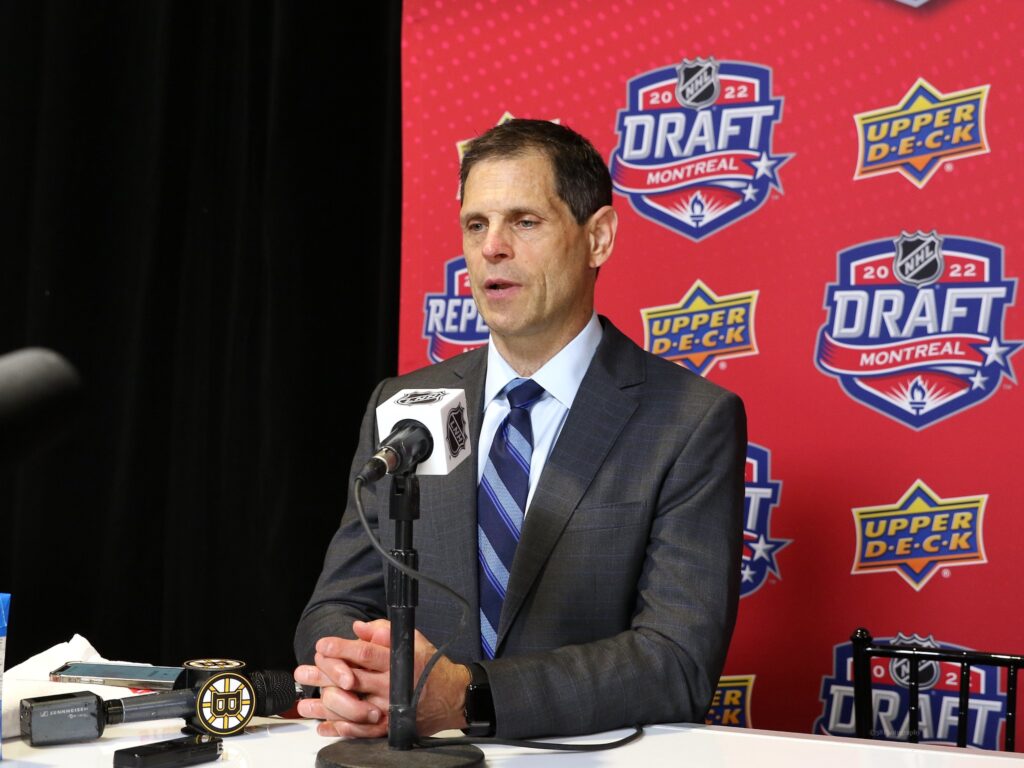For the first time in a long time, the air around TD Garden this fall doesn’t carry the familiar scent of Stanley Cup contention. After a season that saw them on the outside looking in come playoff time, finishing near the bottom of the league, the Boston Bruins are a team in transition. General Manager Don Sweeney has been busy, but if you’re looking for a blockbuster, headline-grabbing acquisition to fix the team’s offensive woes, you’re looking in the wrong place. This isn’t a teardown; it’s a “retool,” a word that can either signal a shrewd, forward-thinking pivot or a prolonged stay in mediocrity. As we head into the 2025-26 season, the Bruins’ forward corps is a fascinating, if concerning, mix of unproven youth, puzzling contracts, and a top line bearing the weight of a franchise on its shoulders.
Also on the EDGE – Can a Healthy Bruins D-Corps Erase the Memory of 2024-25?
The Changing of the Guard
You can’t talk about the new-look Bruins without first acknowledging who’s gone. The departures of captain Brad Marchand, Charlie Coyle, Trent Frederic, and Justin Brazeau represent a clear philosophical shift. The era of the slow, grinding, defensive-minded power forward is over. Sweeney has traded away a significant chunk of the team’s identity, banking on a faster, more competitive approach.
So, who is filling these skates? The free-agent signings were less about replacing star power and more about, in the front office’s words, “culture and an internal sense of competition.” The marquee signing, if you can call it that, was Tanner Jeannot to a five-year, $17 million deal. To put it mildly, this contract is a head-scratcher. Jeannot is a bruising forechecker who has surpassed 200 hits in each of the last three seasons, but he hasn’t cracked 20 points since 2021-22. It’s a steep price for grit, a move that feels more like a reach for an identity than a solution to their scoring problems.

Other additions feel more logical, if uninspired. Sean Kuraly returns on a team-friendly deal, bringing a reliable, versatile presence to the bottom six. Michael Eyssimont and Viktor Arvidsson, the latter acquired for a mere fifth-round pick, are low-risk depth additions. Arvidsson is particularly intriguing; while his finishing touch has faded, he had 59 points just two seasons ago and still excels in transition. The real injection of new blood comes from trades that brought in promising youngsters like Fraser Minten and Marat Khusnutdinov, and the signing of American Hockey League (AHL) top scorer Matej Blumel. The strategy is clear: fill the bottom of the lineup with high-energy, competitive bodies and hope the kids are alright.
The Burden of the Top Line
For the Bruins to have any semblance of success this season, their top line can’t just be good; it needs to be dominant. The trio of David Pastrnak, Elias Lindholm, and the newly-extended Morgan Geekie will be leaned on to carry the offense almost single-handedly.
Pastrnak is, as always, the engine. He remains one of the league’s elite offensive talents. The real questions lie with his linemates. Morgan Geekie’s six-year, $33 million extension came after a breakout 30-goal season where he found undeniable chemistry with Pastrnak. The Bruins are betting that his performance wasn’t a fluke. They need him to be a consistent 30-goal scorer, not a one-year wonder.

Then there’s Elias Lindholm. Signed to be the bona fide No. 1 center, his first season in Boston was a profound disappointment. However, there’s a glimmer of hope. In the final seven games of the 2024-25 season, this line finally started to click, outscoring opponents 15-2 and generating a blistering 12.77 expected goals for per 60 minutes. If that chemistry carries over, they could be one of the most potent lines in the East. If it doesn’t, the Bruins’ offense will be anemic. The pressure on these three men is immense.
Also on the EDGE – Bruins in the Hot Seat: Which Players Need a Big Bounce-Back Season?
Youth, Rumors, and Middle-Six Mayhem
Behind the top line, things get murky. The middle six is a collection of question marks and potential. Pavel Zacha, who dipped to 47 points after two straight 50-plus point seasons, and Casey Mittelstadt are penciled in as the second-line tandem. Mittelstadt is a gifted passer, but his defensive liabilities are well-documented. It speaks volumes that rumors are swirling about both players potentially being on the trade block.
The real excitement, and uncertainty, surrounds the youth movement. After years of waiting, skilled winger Fabian Lysell is expected to finally crack the roster. He has the speed and creativity to provide much-needed secondary scoring. Yet, in a bizarre twist, whispers suggest the Bruins might shop him, citing an “influx of youth.” It’s a confusing message for a team desperate for his exact skill set.

The third line is where the retool truly takes shape. Matthew Poitras, who was a point-per-game player in the AHL, looks ready to lock down the center position. He’ll likely be flanked by Minten, a highly-touted prospect praised for his hockey IQ and 200-foot game. These are the players who represent the future, and their development is arguably more important this season than the team’s win-loss record. They’ll likely be insulated by a veteran like Arvidsson or the pesky Eyssimont, but their performance will be a key barometer for the success of Sweeney’s plan.
An Identity Forged in the Trenches
While the top-six grapples with scoring, the fourth line will be tasked with forging the team’s new identity. This is where the puzzling Jeannot signing finds its home. His heavy-hitting, relentless forechecking style is tailor-made for an energy line. Alongside him will be the ever-reliable Sean Kuraly and the physical Mark Kastelic. This trio, along with Eyssimont, Jakub Lauko, and John Beecher, won’t fill the scoresheet, but they are designed to wear down opponents, win puck battles, and generate momentum. They are the embodiment of the “culture of competition” the front office is trying to build. They will be hard to play against, but can they provide enough of a spark to make a difference when the goals inevitably dry up?
The Numbers Don’t Lie
Let’s be blunt: the Bruins’ offense was atrocious last season. They finished 27th in goal scoring and had a staggering negative-14.78 goals scored above expected, a statistic that screams they have a major finishing problem. Their power play was even worse, a “dreadful” unit that ranked 29th with a 15.2% success rate. The strategy was predictable and stale, revolving almost exclusively around forcing one-timers to Pastrnak.
Have the offseason moves fixed this? It’s difficult to see how. Adding depth forwards and grit specialists doesn’t address a fundamental lack of high-end talent. The power play is crying out for a new approach, perhaps one that gives a creative player like Mason Lohrei more opportunities to quarterback from the blue line. Without significant tactical changes and a surprising offensive explosion from the middle six, the Bruins are poised to be one of the lowest-scoring teams in the league once again.
A Perilous Path Forward
The consensus around the league is that the Bruins will miss the playoffs for a second consecutive year. Sweeney’s offseason has been described as “stagnant,” and the team simply hasn’t done enough to improve in a competitive division. The front office is betting on internal growth and good health, a risky proposition for a team with so many holes.
This season is not about contention; it’s about transition. It’s about seeing if Geekie is the real deal, if Lindholm can rebound, and most importantly, if the next wave—Lysell, Poitras, Minten—can become core pieces for the future. While the present looks bleak, the long-term roadmap hinges on these young players and future prospects like James Hagens. The Bruins won’t be the most talented team on the ice most nights, and the retooling process looks to be a longer, more arduous task than many fans would like to admit. By December, we’ll have a much clearer picture of whether this is a swift retool or the beginning of a long winter in Boston.
Created with the aid of Gemini AI
